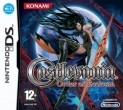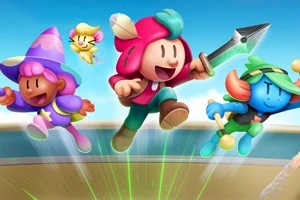Review: Castlevania: Order of Ecclesia
Posted 26 Feb 2009 at 22:21 by Derek Wheatley
DS Review

| "...the union attack looks like a larger version of the weapon itself. For example, having a javelin weapon Glyph on both X and Y, the union attack will be a massive spear, equaling...erm... "massive damage"." |
Damn that Dracula, he just doesn't know when to give up. The Belmont clan have had their hands full sorting him out over the years, but they have long perished. So organisations have been set up to discover ways to stop Dracula when the little ruffian shows up once again. One of these organisations is The Order of Ecclesia, which according to a vocal introduction, is apparently pronounced "Eck-cleese-sha", and they have come across a way which should aid them to prevent Dracula unleashing his reign of vampire terror upon the world. There are some game series' which seem to be fantasy/future versions of others. Advance Wars and Fire Emblem being one example, the Castlevania series on the DS I always think of Super Metroid on the SNES. A massive overworld, with different surroundings all connected, which you'll find yourself going back to earlier parts of the game with freshly acquired power-ups to get to once-before unreachable areas. Does this game carry the trend? Read on…
The method Ecclesia has devised to counter Dracula is a trinity of magical 'Glyphs' (Which just look like magic symbols) called Dominus. The orders' leader, Barlowe, has designated that young female Shanoa will be the human vessel for Dominus. However, other member of the order, Albus, believes he was chosen to be the vessel. Before Shanoa can be integrated with Dominus, Albus takes the three parts (Anger, Hatred, Agony) and runs off. Your quest as Shanoa to hunt down Albus and the three pieces begins.
If you've ever played any of the other Castlevania games on the DS, Portrait of Ruin and Dawn of Sorrow, then you know what you're letting yourself in for. The action happens on the bottom screen, with the top screen being used as a map. A waste I think in this game, which I will explain later. Many of the old enemies return as well as some new ones and even though most of them are old enemies with a twist, they are equally infuriating. The bosses are screen filling entities (most of them) which provide much annoyance as you fall under them many a time before you figure out which weapon Glyph works best. And you will die a lot.


The Glyph system, really doesn't add anything new to the series. In previous games you could attack as much as you like, and casting spells cost MP. In Ecclesia, using your weapon Glyph costs MP, which when you stop attacking fills back up. Each weapon Glyph costs a certain amount of MP to use (And some take HP too), meaning in some cases you'll have to run away from a tough enemy while your meter recharges if you attack too quickly. Even worse is the status effect Curse, which saps all MP for a period of time. If that happens, it is recommended you run away to a room without enemies and wait for the effect to cease. Glyphs are obtained by defeating enemies, and when one appears, hold up and you'll absorb it. Not every enemy seems to drop a Glyph, and those that do don't leave one behind each time you defeat one.
Glyphs can be assigned to the Y, X and right shoulder buttons. X and Y are for your main attacking weapons, and the right shoulder is assigned for more practical Glyphs, such as the Magnes Glyph, which magnetises you to metal points which you can catapult yourself from, not too dissimilar from the Grapple Beam in Super Metroid. Having two weapon Glyphs assigned to the X and Y buttons, it is possible to do a union attack, which doesn't take up MP or HP, but another gauge called Hearts. If the two weapons aren't the same, the union attack will look like a white fireball, but if both weapons are the same, the union attack looks like a larger version of the weapon itself. For example, having a javelin weapon Glyph on both X and Y, the union attack will be a massive spear, equaling...erm... "massive damage". Even though it's a refreshing change on a stale combat system, you can't help but feel it's not really necessary.
The difficulty level is amazingly steep, and even though you'll find yourself levelling up rather quickly at the beginning, it doesn't seem to have much of an effect when it comes to killing enemies. You will find yourself begging for the next room to be a save point which will replenish your HP, since potions are hard to come by, and other health restoring items you may find restore little HP.
One downside is that the game feels incredibly linear. The game world isn't laid out as it once was, with the Super Metroid example mentioned above. The world is in little sections, with an overworld map where you can choose which section to go to next. After moving your way through one section, let's say the forest, a new location opens on the map, with the word "New" above it in case you didn't notice it and was wondering where to go next. Portrait of Ruin did this concept a lot better, as you had a central hub to navigate and paintings to warp. Ecclesia feels more like pressing start and skipping to a level.


The levels are very small, albeit difficult and it doesn't feel as large a world as previous games did, and many of them lead to a boss fight. After playing for just under three hours I'd opened up many locations on my map and taken out about 5-6 bosses (And the buggers didn't even have the decency to leave me a Glyph). Also mentioned about the backtracking with later power-ups, it seems to have slipped Konami's mind at this point. Since then I've had to return to only a few times, and it wasn't for anything really important, but I do hope I am wrong here. However, it seems at the moment that the open freedom that was part of the previous games has been broken into little bitesize chunks.
Disregarding the map, if anything could be labelled as the "main hub" of the game, it would be Wygol Village, mainly because you'll be returning here so many times to heal & save. Here you find that Albus has kidnapped the inhabitants for his sinister scheme, which you will find each one in a level and once you free them they'll return to the village [Strangely managing to survive the same monster filled corridors you had to fight your way through to get there]. These rescued villagers do offer rewards for you saving them, but of course they need a certain number of certain items. Which you have to find scattered throughout the world to bring back to them by yourself.
The backgrounds and the music are unmistakably Castlevania, with detailed stone castles, creepy dark forests and other sinister structures. Some sections have a fluctuating 3D background, such as the Kalidus Channel with its rolling dark waves. Another nice touch is in the library you'll reach later in the game, many ledges are piles of books and books litter the floor, as you walk pages fly into the air. The music, feels both creepy yet sometimes cheerful at the same time, with lots of tolling bells, and doesn't differ from any other Castlevania game. There is some voice acting, apart from the introduction which is spoken and the general character/enemy cries, voices also accompany the villagers as you start and end a conversation, which does get annoying in some cases where you speak to this person many times [The store being a prime example]. It does lead to some helping moments, having a boss shout "Maelstrom!" before she unleashes a high damage tidal wave upon you is a fine indication to run for cover.
I think it's safe to say that if you want to play this, it might be wise to pick up a copy of either Portrait of Ruin or Dawn of Sorrow to ease yourself into the series and the challenge what awaits you. Unless you feel like diving into the deep end, go for it!
N-Europe Final Verdict
Because this game has a steep difficulty curve, you'll consider it an insult if you don't keep going back until you've nailed that section/boss.
- Gameplay4
- Playability4
- Visuals4
- Audio4
- Lifespan4
Final Score
9
Pros
Added twist on the Castlevania format you know and love
Interesting Glyph system
Difficult
Cons
Maybe a little too difficult
Short levels broken up by a map
























